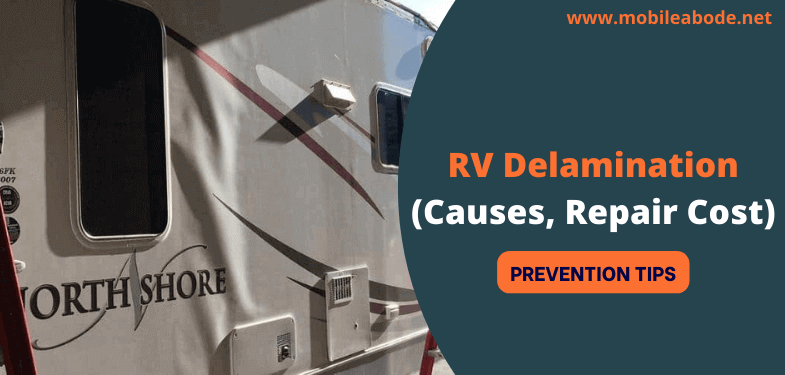RV delamination is a common problem for RVs. It is the separation of the outer layer of fiberglass from the inner layer. This can be caused by many reasons.
While it can be a costly repair, it is important to address any delamination issues as soon as possible to prevent further damage.
In this article, we’ll explain what delamination is and how to recognize if your RV has been affected. By understanding the signs and causes of RV delamination, you can take steps to protect your investment and keep your RV in good condition.
RV Delamination (Causes, Repair Cost & Prevention Tips)
Delamination occurs when the layers of fiberglass or other material that make up the exterior of an RV begin to separate. This can be caused by water damage, impact or even just age and wear.
Symptoms of delamination include bubbling or peeling of the exterior finish, cracks or holes in the walls and a general weakening of the structure. If left unchecked, delamination can lead to serious problems like leaks, mold and even collapse.
Delamination is one of the most serious problems that can affect an RV. If you suspect that your RV has any type of delamination, it’s important to have it inspected by a professional as soon as possible. The best way to avoid delamination is to keep your RV in good condition and to regularly inspect it for any signs of wear or damage.
What Causes RV Delamination?
The causes of delamination on an RV include:
- Water damage: When water seeps into the RV through leaks in the roof or windows, it can cause the plywood and fiberglass layers to come apart.
- Improperly installed siding: If the siding on an RV is not installed correctly, it can create gaps that allow water to enter and cause delamination.
- Age: As an RV age, the adhesive that holds the layers together can break down, allowing moisture to seep in and causing delamination.
- Exposure to extreme temperatures: Extreme cold or heat can cause the different materials in an RV to expand or contract at different rates which can lead to delamination.
- Poor maintenance: If an RV is not properly cleaned and maintained, it can create an environment that is conducive to delamination.
How To Fix Delamination In Motorhomes?
The best way to fix delamination in motorhomes is to prevent it from happening in the first place. Regular maintenance and inspection of your rig can help you catch any early signs of delamination and take care of it before it becomes a bigger problem.
- Be sure to clean and wax your rig regularly.
- Pay special attention to areas where water or moisture can collect. If you do find delamination, there are a few different ways to repair it, depending on the severity of the damage.
- For small cracks or chips, you can use a sealant or an epoxy resin.
- For larger areas of delamination, you may need to replace the affected panel or section entirely.
With proper care and maintenance, you can keep your motorhome in great condition and avoid the hassle and expense of dealing with delamination.
RV Fiberglass Delamination
If you’ve ever had your RV’s fiberglass exterior delaminate, you know it’s a serious problem. Not only is it unsightly, but it can also lead to structural damage if left unchecked.
There are a few different things that can cause RV fiberglass delamination but the most common is moisture. When water gets into the RV’s structure, it can cause the layers of fiberglass to separate, which leads to delamination.
There are a few ways to prevent RV fiberglass delamination, but the most important is to make sure that your RV is well-sealed.
RV fiberglass delamination can be a serious problem, but it’s one that you can avoid with a little bit of care and attention.
Average RV Delamination Repair Cost?
The cost of repairing a delaminated RV can vary depending on the severity of the damage and the size of the RV. For minor delamination, repairs may cost as little as $500. However, for more severe delamination, repairs can cost upwards of $5,000 or more.
Additionally, the cost of repairing a delaminated RV will also depend on the type of RV, as well as the materials used to construct it. Therefore, it is important to consult with a professional RV repair technician to get an accurate estimate of the repair costs.
Should I buy a used Travel Trailer with delamination?
No, you should not buy a used travel trailer with delamination. Delamination is a serious issue that can cause extensive damage to your RV, and it is very expensive to repair. If you are considering purchasing a used RV, make sure to have it inspected by a professional before making any decisions.
Because delamination is caused by water damage, it is often not covered by insurance. This means that if you do have delamination on your RV, you will be responsible for the entire repair bill.
If you are considering purchasing a used travel trailer, we recommend that you avoid any RVs with visible signs of delamination. Even if the RV is otherwise in good condition, delamination can cause serious problems down the road.
Prevention Tips For Delamination on an RV
Following are the preventing tips for delamination on an RV:
- Make sure that the RV is well-ventilated.
- Use a dehumidifier to control the humidity levels inside the RV.
- Inspect the RV regularly for any signs of delamination and take corrective action immediately if any such signs are noticed.
- Use only high-quality materials for the construction of the RV.
- Make sure that the RV is stored in a cool and dry place when not in use.
- Do not park the RV under direct sunlight for extended periods.
- Use a UV protector spray on the exterior of the RV to protect it from the harmful effects of the sun.
- Wax the RV regularly to protect the exterior from weathering.
- Do not clean the RV with harsh chemicals or abrasive materials.
- Follow all the manufacturer’s instructions regarding the care and maintenance of the RV.
It is important to take preventive measures to avoid delamination. By following the above tips, you can prevent delamination on your RV and keep it in good condition for many years to come.
FAQs – Camper Delamination
What does RV delamination look like?
RV delamination can often be identified by changes in the exterior finish of the RV. Cracks, ripples, or other irregularities in the finish may indicate that delamination is occurring. If you detect delamination, have your RV inspected as soon as possible by a professional.
What causes fiberglass delamination?
Fiberglass delamination is caused by water seeping into the fiberglass and separating the layers. This can happen if there are cracks or holes in the fiberglass, or if the sealant around the edges of the fiberglass is not properly applied.
Fiberglass delamination can also be caused by improper storage or installation of the fiberglass.
How do you check delamination on an RV?
There are a few ways to check for delamination on an RV.
- One way is to look for cracks or separations in the exterior walls of the RV.
- Another way is to inspect the roof of the RV for any leaks or water damage.
- Finally, you can also check the floor of the RV for any soft spots or give in to the flooring.
Why is my camper floor spongy?
The most likely reason for a spongy floor in your camper is that the subfloor has become wet. The subfloor is the layer of plywood or other material that sits beneath the flooring and provides support.
If this layer gets wet, it can start to break down and rot, which will cause the floor above it to become spongy.
Are fiberglass or metal campers better?
There is no clear answer as to whether fiberglass or metal campers are better. Each type of camper has its advantages and disadvantages.
Some people prefer fiberglass campers because they are lighter in weight and easier to tow. Fiberglass campers also tend to be more durable than metal campers, and they are less likely to develop rust or other problems.
However, metal campers have some advantages as well. They are typically less expensive than fiberglass campers, and they tend to be better insulated against the cold. Metal campers can also be easier to repair if they become damaged.
Ultimately, the best type of camper for you will depend on your personal preferences and needs.
Conclusion:
Delamination on an RV is a serious issue, and it’s important to know the signs of delamination so that you can address the problem as soon as possible. If you think your RV might be experiencing delamination, take it to a qualified technician for inspection.
Delamination on an RV can be a costly and frustrating experience. However, it is not as common as some people may think. If you are diligent about inspecting your RV and keeping it well-maintained, you should be able to avoid most problems with delamination.

